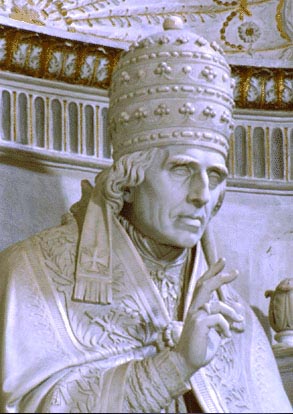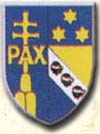 |
| Grottoes
Vatican City Colonnade Saints Floorplan #2 |
| Altars
Monuments The History |
|
Related Sites |
|
Like his predecessor, Pius VII endured imprisonment by Napoleon. He restored the Jesuit order in 1814. His secretary of state, Cardinal Consalvi, commissioned this monument by Thorvaldsen (the only Protestant sculptor in St. Peter's). A fanciful story developed that Thorvaldsen, being a protestant and not allowed to sign his work, carved his own face on Pius VII's body. A simple look at the portraits of each, prove this not to be the case. |
 |
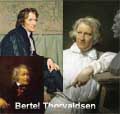 |
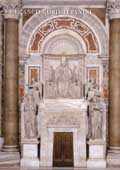 |
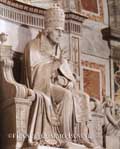 |
From: The Basilica of Saint Peter's in the Vatican by Franco Cosimo Panini
The funerary monument of Gregorio Luigi Barnaba Chiaramonti, born at Cesena
(Forli) in 1742, pope from 1800 to 1823 with the name of Pius VIII, was
made between 1823 and 1831 by the Danish sculptor Bertel Torvaldsen, from
whom it was commissioned by Cardinal Ercole Consalvi. It is on the east
wall of the Clementine Chapel, backing onto a large arch surmounting a
doorway which gave access to the Chapel of the Choir but is no longer
in use. The papal throne flanked by two angels, rests on the architrave;
at the sides, on separate bases, are Divine Fortitude, wearing a lion's
skin and with her arms gathered to her breast, and Wisdom, crowned with
oak-leaves and with her eyes cast down.
From:
'St. Peter's - Guide to the Basilica and Square'
The Monument of Pius VII (1800-1823) occupies part of the left wall of
the Clementine Chapel. He was the Pope imprisoned by Napoleon and exiled
to Fontainebleau. After his liberation, he did all he could for the emperor
exiled at Sant' Elena and helped his elderly mother. The weary Pontiff
is seated majestically on his throne and is blessing all, friends and
enemies. The monument is the work of the Danish sculptor, Bertel Thorvaldsen
(1770-1844), Roman by adoption. Beside the Pontiff are two allegorical
figures: the Genius of time and History, intent on recording the Pope's
achievements with the hourglass and a book; on the pedestal are another
two statues which represent Fortitude, with the lion skin, and Wisdom,
with the book and the owl.
From:
'St. Peter's Basilica - A Virtual Tour' by Our
Sunday Visitor
On the other side of the Chapel is the Monument to Pius VII by A. Thorvaldsen,
the most valid of Canova's followers, who executed a work accurately described
by Galasso Paluzzi as showing a "tiresome ostentatious overabundance."
In fact, in his quest for simple stateliness and severity, there is little
relationship between the sculptures - the emaciated Pope seated on a throne,
the two winged spirits at his side and the excessively small statues of
Time and History - and the naked, square base, somewhat out of character
with the upper part decorated with rays.
The monument to Pope Pius VII was created by Bertel Thorvaldsen. The work,
balanced between a Canova-type inspiration and the subsequent naturalistic
and neo-15th-century requirements, lacks compositional and interpretative
emotional unity, since it is overly symmetrical and rhetorical. On the
other hand, without the originality and sensitivity of Canova, it was
difficult to match the neoclassical needs with sincere Christian acceptance
about such a theme. In addition, the Danish artist is unable to create
harmony between the whiteness of the central funereal temple and the surrounding
statues, and the placid multicolored hues of the rear niche. The Pope
seated at the See, in the act of blessing, appears too stiff in his solemn
garments, almost as if he were posing for an official picture. The expression
of the face is more effective, and shows the signs of the exile and his
long and troubled reign. Two winged cupids with more minute proportions,
one symbolizing time (hourglass) and the other history (book), are located
on the sides of the throne. The two statues of "Knowledge" and "Fortitude"
are located on the sides of the Doric door, on high pedestals. The first
is depicted in a meditative pose, with the Bible open, and at its feet,
an owl, the symbol of prudence. The second figure is dressed in lion skins,
while one foot stands on a club.
From: 'Lives of
the Popes' by Richard P. McBrien
On August 7, 1814, the feast of St. Ignatius of Loyola (now celebrated
on July 31), in spite of protests from the Catholic powers, Pius VII restored
the Society of Jesus.
After falling and breaking his thigh some six weeks earlier, Pius VII died on August 20, 1823, two years after his nemesis, Napoleon Bonaparte, and was buried in St. Peter's. His longtime, faithful secretary of state, Cardinal Consalvi, sold all his precious objects and had a grand monument ... erected in Pius VII's memory.


